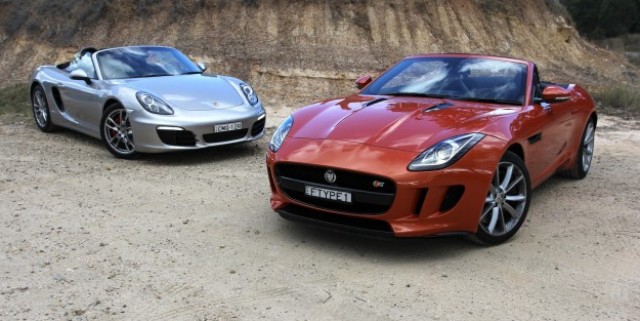
It's both the moment of this comparison test and the first time the Jaguar F-Type mounts a fierce challenge to the Porsche Boxster.
The $171,045 F-Type V6 S is leading, with the $131,800 Boxster S PDK on the chase. We're on a special slice of road deserving of two hot roadsters. It's early morning so the trucks that typically ferry coal from the mines to nearby power plants are likely still being filled, and the road is clear. It's way too cold for roadsters – we're talking single-digit degrees and sleepy winter sun – but each fabric roof has been electrically folded anyway.
Approaching this particular winding uphill stretch the F-Type is howling ahead. The outputs of its 3.0-litre supercharged V6 engine – 280kW of power produced at 6500rpm and 460Nm of torque at 3500-5000rpm – are transferred through an eight-speed ZF automatic transmission to the rear wheels to achieve a claimed 4.9 second 0-100km/h.
The Boxster S doesn't get a supercharger or a turbocharger, and its 3.4-litre flat six-cylinder can't win a pub argument with 'only' 232kW at 6700rpm and 360Nm from 4500-5800rpm. Yet with a kerb weight of 1350kg, the Porsche is a staggering 247kg lighter than the Jaguar. The F-Type, to be fair, is almost exactly 100mm wider and longer, but it is uniquely constructed entirely of aluminium, so it shouldn't really be that portly. Incidentally, it is claimed the F-Type is more of a cut-price competitor for the 911, but with only two seats and a pricetag closer to the Boxster, we're not buying that.
So the Boxster S, utilising a seven-speed dual-clutch automatic, sprints only a tenth slower to triple figures, except with the optional launch control (not fitted to our test car) it is actually a tenth faster, according to each manufacturer's claims.
What the Porsche doesn't have is the mid-range punch or the sound of the Jaguar. Back to that straight before the uphill bends, and the F-Type V6 S is crushing the Boxster S into an increasingly smaller rear-view mirror dot.
The twin centrally-mounted exhausts on the F-Type V6 S ?have clearly been donated by the Queen's battalion. They fire bangs, pops and crackles into the crisp morning air – overlaid with a hint of typically-British whining from the supercharger – almost emasculating the Boxster S by comparison.
The Porsche may swing to 7800rpm, and offer the most wonderfully incisive throttle as most naturally-aspirated engines do, but the 3.4-litre doesn't sound as creamy and sweet as the 2.7-litre in the base Boxster, the engine of which was last driven in the Cayman tested last month. Sure the bigger engine is quicker, but its industrial thrash-metal soundtrack is less characterful.
The optional (and expensive, at $4790) sports exhaust on our Porsche test car isn't anywhere near as fruity or forceful as the standard Jaguar pipes, though it still tingles the ears nicely.
Our Boxster S is otherwise, surprisingly, not optioned up at all. The only worthy options it misses, however, are torque vectoring with a mechanical limited-slip differential ($3190) and a sport steering wheel with proper paddles, which replace the clacky, anti-ergonomic buttons on the wheel of our test car.
Experience with a Boxster S equipped with optional ($2710) Porsche Active Suspension Management (PASM) has proven it makes the ride quality a fraction more settled on the standard 19-inch alloy wheels compared with the standard car, but it isn't a critical difference unless you're trading out of a Nissan Maxima.
By comparison the F-Type V6 S – which already starts $40K behind – comes standard with Jaguar's version of all of the above, including proper paddles. That's in addition to other optional kit on the Boxster S, including rear parking sensors (with front sensors – $890), bi-xenon headlights ($1350) and six-way electric-adjust seats (14 way – $1900). But, then, Jaguar really are taking the mickey with other items fitted to our test car, but which should be standard, such as rain sensing wipers ($510), dual-zone climate control ($980), lockable interior stowage ($590) and 'special paint charge' ($5620) among others.
The Jaguar has all the gear for that wide, sweeping uphill left corner that follows the short straight. Well, except that it has a big long bonnet with an engine mounted beneath it, compared with the Boxster, which has my substantially lighter laptop bag up front and the engine in the middle.
Yep, the mid-engined Porsche is renowned for its perfect balance, so it's lucky, then, that the F-Type's prodigious performance has given it such a lead into the snaking bit of this road that will last for the next 50km.
Punting the F-Type up front, the Brit roadster quickly proves reminiscent of the original BMW Z4, before it turned heavy and lazy, or a smaller version of the Mercedes-Benz SLS AMG. It's all about bum-on-axle involvement and guiding a long nose into corners, which is not unlike swinging a cannon around and holding on as it fires.
Despite its on-paper heft, the Jaguar feels extremely nimble and light on its feet. Even sitting low in the cabin it feels wider, especially, than the Porsche and longer as your eyes gaze over a snout that turns in with surprising alacrity.
Flicking the chequered flag toggle on the F-Type console turns the dials red and hardens up the suspension, while activating the torque vectoring and turning the stability control to Trac DSC mode.
As ever with front-engined cars, patience is required to settle the nose, but the F-Type works its 20-inch tyres hard and ?pins a tight inside line with little trace of understeer. Hit the sharpened-up throttle earlier than you'd think you can and the Jaguar segues into a sublime oversteer drift, maintaining enough speed to keep it ahead of the Porsche. It feels as though your hips are screwed into the back axle.
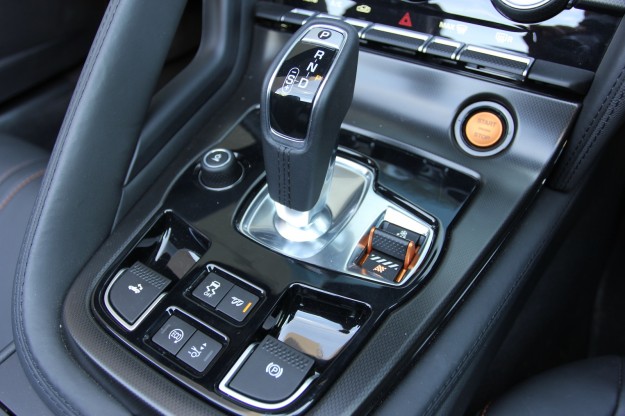
Having previously driven the Boxster S on this slice of road, it's obvious that although the F-Type can shout louder, it can't match the epic entry and mid-corner speeds of the mid-engined Porsche.
A quick rear-view mirror glance proves there really is little need for cornering restraint in the Boxster S. It rushes into the same corner faster and harder with little need to settle the nose. It smears its fronts into the tarmac at speed and readily accepts early full throttle early which smears the rears too. It is just about the world's most finessed car; the balance is impeccable.
After the next cresting right-hander the Porsche is tucked up hard under the pipes of the Jaguar. That's despite the F-Type doing some really clever things to tame overly hot corner entry speed. You can feel the torque vectoring working, in conjunction with the Trac DSC subtly pinching a front brake to help it pin a tight line.
That stability control calibration is superb, as is the light, sharp and direct steering that threads plenty of road feel up to the kransky-sized wheel rim and driver's hands. Indeed Jaguar is one of few manufacturers to have maintained traditional engine pump-driven hydraulic power assistance for the steering, as opposed to the electric motor-driven system employed by Porsche, which is claimed to save 0.1L/100km but also loses feel.
Before the F-Type is bullied off the road – a rare instance if the car is well driven, unless of course a Boxster is behind – it's time to swap cars. Very quickly it is apparent that Jaguar has landed a couple of blows on the plucky Porsche's chin.
The steering in the Boxster S reveals a slight loss of motion on centre, where the F-Type is sharp, progressive and feelsome all at once. It's a small chink in the armour because whenever more than a degree of lock is used, the Porsche steering is sublimely direct and wonderfully connected. Again, however, the weighting of the Boxster S helm is just a touch heavier than the F-Types, yet the Jaguar proves that easier movement around the dial doesn't necessarily translate to less accuracy; it is both easier and better.
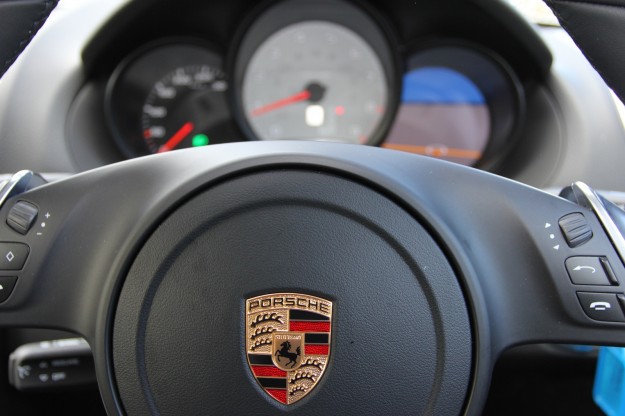
Equally, though, the Porsche Boxster S shows that is far more than just a surgeon-like operator like, say, the point-and-shoot Audi TT RS. Rather it indulges in front-to-rear play while communicating what its chassis is doing through its major controls with the clearest enunciation. Its throttle, for example, is intrinsically linked to the driver's foot and what the tachometer reads.
The Porsche also smashes through the rear-view mirror of the Jaguar whenever the road surface is less than perfect. It feels stronger in its body than the Jaguar, and even with the standard fixed suspension the Boxster S delivers far superior ride quality. Suddenly, what was deemed as acceptably-firm, if slightly jiggly suspension in the F-Type is overly intrusive by comparison.
Rough country roads also elicit a slight buzz through the Jaguar's A-pillars that is never, ever present in the Porsche, and the otherwise superior steering is let down by rack rattle over mid-corner bumps isn't felt in the Boxster.
When the pace is raised several tenths, the brilliant PDK transmission also shades the ZF automatic in the Jaguar, the latter of which is smooth and incisive, but also a bit slow to downchange when the heat is on and the left paddle is slapped.
The Porsche dual-clutch, by contrast, is faultlessly fast and more aggressive in its Sport mode than the Jaguar's is. Yet despite decoupling itself from the engine when cruising at speed, and stopping the engine at standstill, both with the aim of saving fuel, the Boxster S used more fuel on this (admittedly hard-driven) country-road drive loop. The Porsche, at 15.4L/100km on-test, also exceeded its combined consumption claim of 8.0L/100km by a greater percentage, while the supercharged Jaguar, managed 15.0L/100km on-test, up on its 9.1L/100km claim.
Without the optional ($3890) Sport Chrono pack that puts an analogue clock between the central vents of the interior, though, the Boxster interior is a fraction bland. Yet the ergonomics of the Porsche touchscreen and simple (and, unlike the Jaguar, standard) dual-zone climate controls are fine, and there's a real feeling of solidity and quality.
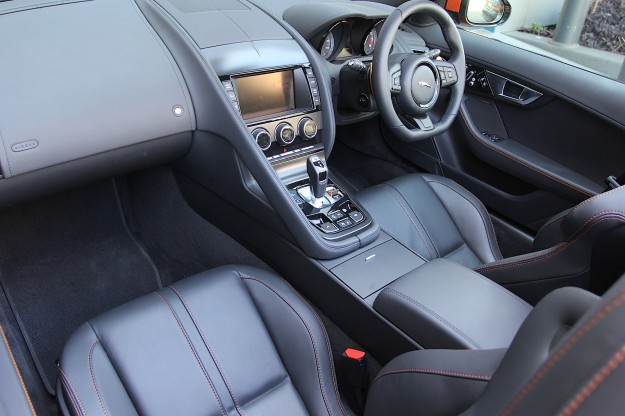
As with the exterior, and by contrast, the F-Type cabin is far more brash. The optional ($2730) 'performance' seat and optional ($3970) premium leather interior looks and feels superior to the standard Boxster units – the Porsche even gets partial manual seat adjustment – but just how much better they are compared with the standard items we don't know.
The rising centre vents in the Jaguar are as theatrical as the exhaust sound, but we can't help but feel, pragmatically, that they add weight to an already-heavy car. The touchscreen ergonomics aren't a jot on the Porsche's, with some climate controls changed via the knobs on the dash and some requiring the driver to delve into the touchscreen interface, for example. That said, details like the metallic-gold-painted chequered-flag toggle switch ooze cool Brittania.
But the biggest area where the F-Type gets pummelled by the Boxster is in terms of usability. The Porsche's twin boots – one front, one rear – offer a combined 280 litres of space. By comparison, the Jaguar's shallow but wide boot delivers a paltry 196L.
At the start of this comparison, having not driven the F-Type, it was questioned why Jaguar didn't build a direct Boxster or 911 rival, but rather position its car in between. Now it makes perfect sense. The F-Type isn't trying to be either rival, not technically, nor in character. It is absolutely its own thing, and is all the better for it.
It isn't, ultimately, as heroic as the Porsche Boxster S, which is both technically perfect and wonderfully charming. If the Jaguar F-Type V6 S was cheaper, more rigid, smoother riding and more practical, its loud and proud personality may have helped it over the line.
It must be devastating for the Brits to build a 4.5-star car that comes second. Equally, however, they should be pleased its first new roadster in decades can land the occasional blow on, and be considered a valid alternative to, the world's best roadster and one of the best cars on the market regardless of genre or price.
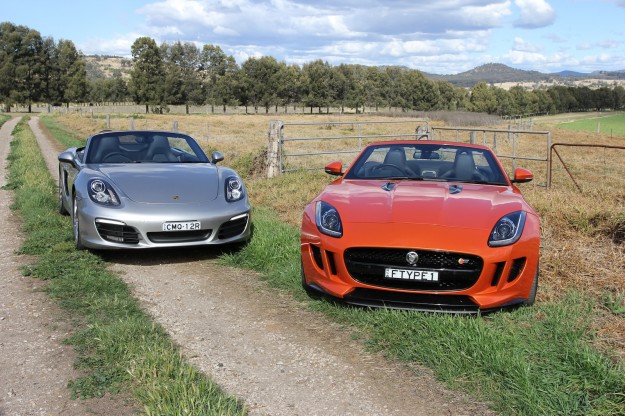
Jaguar F-Type V6 S
Price: $171,045
Engine: 3.0-litre supercharged V6
Power: 280kW at 6500rpm
Torque: 460Nm at 3500-5000rpm
Transmission: 8-speed automatic
Fuel consumption: 9.1L/100km (15.0L/100km on-test)
CO2 emissions: 213g/km
0-100km/h: 4.9 seconds
Weight: 1597kg
Porsche Boxster S PDK
Price: $131,800
Engine: 3.4-litre 6-cyl
Power: 232kW at 6700rpm
Torque: 360Nm at 4500-5800rpm
Transmission: 7-speed dual-clutch auto
Fuel consumption: 8.0L/100km (15.4L/100km on-test)
CO2 emissions: 188g/km
0-100km/h: 5.0 seconds
Weight: 1350kg





